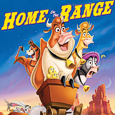Walt Disney Feature Animation (April 2 2004), Walt Disney Home Entertainment (July 3 2012), Blu-ray Disc plus DVD, 76 mins plus supplements, 1080p high definition 1.78:1 widescreen, DTS-HD Master Audio 5.1, Rated PG, Retail: $29.99
Storyboard:
Famously the last – for a while at least – traditionally produced animated feature from the Mouse House, Home On The Range’s wild-west spoof story is as basic as can be, with lady Pearl’s farm, dubbed her little Patch Of Heaven, up for lease renewal. This comes in handy for one Y. Odel, who has been buying up lots of land in the area due to lower rates brought on by cattle rustler Alameda Slim. Turns out that Slim and Odel are one and the same, with Slim’s boys downing the land price by getting folks to shut up shop and move out, while Odel moves in and buys up the land – and the stock – at cut price rates! With Pearl’s farm on the block, her animal herd is joined by Maggie, orphaned from one of Slim’s rustling outings, who gets it into her head that she can help her new family by teaming up with the two other cows on the lot, Mrs Caloway and Grace, to track and capture Alameda Slim and gain the reward money…yep, you got it – exactly the $750 needed to save Pearl’s Patch Of Heaven farm!
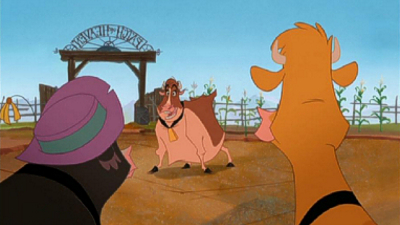
And so they set out, up against a mysterious bounty hunter, Rico, and Buck, a crazy horse from the Sheriff’s office who’s out to impress Rico and become his ridin’ pardner. They’re all in for much more than they bargained for, however, when they catch up with Slim and find that his favored “secret weapon”, a crazy yodel, is enough to enchant any cow and send them willingly off to the slaughter! Will Rico get there in time? Will Buck shape up and become the hero he dreams himself as? Or will our “bovine bounty hunters” end up headed for the chops and not even good enough for milkshakes? Looks like the stage is set for a good old-fashioned showdown with an udder-ly twisted twist!
The Sweatbox Review:
When Disney’s original – and thankfully not apparently permanent – farewell to traditional Burbank-drawn hand animation was first released theatrically almost ten years ago, I must admit to shedding a tear or two on the way to the theater. Until the Studio set itself right again, under the new leadership of John Lasseter, and started producing the very kinds of films – The Princess And The Frog, Winnie The Pooh – that had sealed its legendary reputation, all fans could look forwards to was a future of “diet Disney”: sequels and knock-offs from the direct-to-video Toon Studios based down under. Broken for the first time in over 20 years was the production line that started with Snow White And The Seven Dwarfs in 1937, and continued through Walt’s death with The Jungle Book.
Even in the early 80s, when Disney Feature Animation looked doomed and there was not anything in production other than the fated Black Cauldron, there was the hope of Musker and Clements’ return to casting mice at Disney, with the resulting The Great Mouse Detective kick starting a new trend of non-stop production and hits, resulting in the Academy Award nod for Beauty And The Beast and the box-office domination of The Lion King. In many ways, it was those films that both validated Disney animation as a commercially sustainable art form…and began the slow road to killing it off at the same time. The “toon boom” of the 1990s led to a variety of companies stepping into the field, not least Disney’s own partnership with Pixar and the rise of PDI/DreamWorks, their biggest rival.
With these two new kids on the block, providing the whiz-bang fireworks of Toy Story and Shrek, no wonder the handcrafted, staunchly traditional Disney began to look old hat. Now, I loved the then-recent Disney films, especially Tarzan, Lilo And Stitch and Treasure Planet…but even as big a fan as I could see the argument that they had become formulaic, old-fashioned in tone and sometimes almost carbon-copies of past achievements. Once upon a time, Disney films had been fresh, but – and even including Lilo And Stitch at its core sentiment – they had become the same film over and over, albeit dressed in ever increasingly opulent visuals. The boom of CGI’d productions coincided with the general dumbing-down of movies, due in part to special effects, where now anything is possible and every new film must top the last.
But where CGI animated films have had most success is in the rather bland, easy to please family comedy market – a market that, let’s not forget, Disney had primarily forged itself and even where the Lilo And Stitch is arguably still the most recent genuinely traditional smash hit movie. In skewing their more recent (CG) animated attempts to appeal to this demographic, Disney found itself straying away from what kept them at the top of the animation game in the 1980s and 90s, trying to find a “please all” solution that produced, for a while, animated movies that didn’t really appeal to either casual animation fans or even Studio die-hards.

Into this fray stepped Home On The Range, finally released as a loud, brash and broad comedy after several years (and even more re-writes) on the boards as a widescreen epic named Sweating Bullets, originally about a young bull’s adventures in an old western ghost town. If this sounds a little more sombre than the humorous bovines we come to know in the movie was released, well, this is merely the result of top brass management not having faith in their own projects, much as in the same way The Emperor’s New Groove switched from being the epic Kingdom Of The Sun. But even with these changes – which worked for Groove – Home On The Range came and went pretty quietly in what was an awfully dumped-out early April slot, without much of a fanfare from the Mouse House, and overall mixed reviews from critics.
Whereas The Emperor’s New Groove just about passed the test, and all holes between its original dramatic intentions and eventual comedic result were covered up, Home On The Range feels a little more disjointed and even less focused, and the short running time doesn’t help hide the fact that it looks like it’s been stitched together as quickly as possible. In fact, this animated adventure was supposedly ready to roll into theaters a full year before the Studio’s originally intended next film, Brother Bear, which was rushed through production through in order to coincide the release with another cute furry-animals movie, The Lion King, on DVD.
In a way, I was glad for that, since it meant, as it was then feared and was to be the end of Disney’s traditionally animated feature films, at least the “honor” would have fallen to a production realised at the Burbank facility that championed the art form for all these years. Not that the later Florida-animated features (Mulan, Brother Bear, Lilo And Stitch) didn’t have their own merits, and it’s true that this satellite facility did also contribute much to the Burbank features too, but I did often find a hint of “simplicity” to some of those films’ design; a more “cartoony” approach that was also reflected in some of their personality animation.
This is an interesting line to take with Home On The Range too, which does sport a simpler, more angular look that’s more associated by most to Warner Brothers’ Looney Tunes cartoons (the backgrounds, for instance, are very reminiscent of Chuck Jones’ Road Runner shorts). In fact, Walt himself began this trend in Disney pictures with shorts such as Pigs Is Pigs (the title characters of which bear a striking similarity with the pork choppers in Home On The Range), and the same style had been adapted as the look for The Emperor’s New Groove. There’s also no denying that Home On The Range shares more than just this with that film (even counting their joint, troubled production histories).
This not-quite UPA 1950s style slots right in to the Disney shorts made around that era (Walt put out a fair share, including the likes of Paul Bunyan) and only looks “new” thanks to the more refined outlines computer assisted production can bring, and the spot, here are there, of CG-enhanced props and backgrounds. But for the most part it’s good old painted artwork throughout, something that lends the film a charm that could otherwise be missing. The designs are certainly nothing to shout out about, and, as even touched on above, supporting cast members look as if they’ve been pulled from older Disney cartoons (could this be intentional?) and seem more than familiar (a way, possibly, of bringing a full personality to a character already steeped in familiarity).

But Home On The Range is all animated with that unmistakable fluid Disney-animation technique – albeit with the likes of Andreas Deja, Mark Henn and Dale Baer pulling their best Chuck Jones and Tex Avery impersonations – with fine, flowing lines and movement that somehow always works, even when we are more used to seeing these kind of designs treated more aggressively in perhaps more vigorous short films (something that could be levelled at this film is its relentless and even tiring short-film style pace). While the designs may be as good as they need to be and the animation as good as we expect it to be, there are a few added layers which help lift Home On The Range just above the status of an otherwise rudimentary affair and beyond the unfair criticism and reputation as a dud that the film has gained.
Buck’s visions of himself as a Wild West hero mark out some of the best work in the film, with darker lighting and a more dangerous tone brought in to offset his wackiness. These sequences also narrow down to a wider 2.35:1 ratio (rather than opening out wider like Brother Bear), with black mattes filling in top and bottom to create the classic western film frame of a Sergio Leone epic (touches of Ennio Morricone’s music highlight in the score at these points too). Likewise, some of the characters are big, big plusses, such as Lucky Jack, a not-so-lucky jack rabbit who helps the cow-girls on their quest, and Slim’s assistants the Willie Brothers – possibly the dumbest fun characters in all things Disney (and is that a nod to Ward Kimball when one of them dons glasses?)
Adding to the characters are the spirited performances, among them Roseanne Barr as Maggie, Judi Dench as Caloway and Jennifer Tilly, here not playing against her general image as dumb blonde Grace. Randy Quaid, as Slim, isn’t given too much to do, but he chews each scene up with relish, while a couple of surprise “cameo roles” go to Steve Buscemi and Patrick Warburton, who provides one of the biggest laughs with his offhand delivery in his brief single scene before a lot of exposure eventually made his voice more and more wearisome in recent times. As a comedienne, Barr has never been known for her subtlety, and here she plays it just like her TV show appearances: infectious to be sure, but one that may also be a little overbearing for the film: we’re never in doubt as to who the “star” is here with all the shouting going on.
Dench is a little more relaxed, bringing, appropriately, a warm tone to the film and subtle depth in the acting, which helps the more resonant parts hit home more. Also helping in this regard is the return to Disney features by Alan Menken, who had been concentrating more on the stage adaptations of his previous features The Little Mermaid and Beauty And The Beast. In a strange way, his work here compliments the film perfectly, not being anything near as memorable as those outings while not being throwaway tunes. Menken doesn’t really play with western conventions, apart from a predictable honky-tonk piano, banjo and some heartstring-pulling harmonica, and the score does remain somewhat secondary to the dialogue and songs for much of the time.

That’s not normally the case with a Menken score, which frequently belongs in, and lifts every scene, but at least the songs make a splash: Yodel-Adle-Eedle-Idle-Oo, sung by Randy Quaid (with a bit of yodelling help) as Alameda Slim, seems to be the high point that people will come away humming, but it doesn’t quite work for me. Certainly, lyricist Glenn Slater doesn’t have the knack for colourful word play that Menken’s late partner Howard Ashman did (and as proven by his subsequent great, but not spectacular, work with Menken on Tangled). There seems to be a lack of inspiration, and even with comedy material like this, which Menken usually excels with (as in Little Shop Of Horrors and Hercules), Slater just can’t seem to jump start the show.
Some of the lines work (“Out where the fearless get the shudders, Justice is here and it’s wearin’ udders”) but for the most part the lyrics are mostly moderately amusing as opposed to being hugely hilarious, although the melodies do work overtime to make these moments the best they can be. Where the inclusion of songs really works is with Will The Sun Ever Shine Again? (sung by Bonnie Raitt, sounding very much like a young Bette Midler), easily the film’s most memorable melody although even here the intended emotional wallop is subdued in its reminding us of When She Loved Me, from Toy Story 2, a prompt which further suggests that, while Home On The Range is its own film, it can seem awfully over familiar at times. However, in retrospect, it’s also easy to see the song as a prayer from the Disney artists, who at the time of production may have well been wondering if the sun would ever shine on their particular brand of animation ever again…
Overall, the score offers an interesting cross of styles, being a combination of character-led songs and the overlaid tracks we’ve come to be used to in recent Disney fare. It works, though, and even when characters are not singing directly on-screen, one gets the feeling that this is what their inner-voice feelings are saying, more so than Phil Collins’ tracks for Tarzan and Brother Bear, which seemed to imply more of a forward momentum “story song” or thought process. Nevertheless, it’s always good to have Menken “back in the saddle”, and the fact that he even gets to feature notably on the film’s soundtrack here is testament to his talents as a songwriter and singer.
The ups and downs of production obviously had a few effects on the final film, but for the most part any cracks have been papered over well enough, and even Maggie’s narration – usually the first sign that a film has been stitched together and a voice track used as glue – seems to flow naturally and never feels shoe-horned in at the last minute. As for Home On The Range’s somewhat infamous PG rating, well, apart from one line (the overused “yeah, they’re real!” in the publicity), there’s really nothing to get upset about, and the rest of the film actually plays on a slightly lower level, certainly aimed more at the kids, with the now seemingly obligatory wind gags included – but don’t worry: there’s nothing Blazing Saddles about this film in that regard!
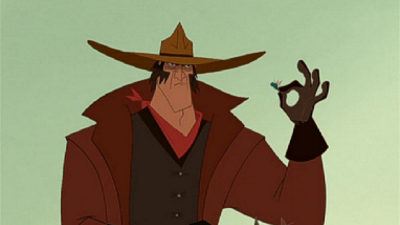
Animated westerns have always been hit and miss affairs. It’s certainly worth hunting down the English-language dub (by Rich Little) of the original French feature Lucky Luke to see how it can be done right. On the knock side, Spirit: Stallion Of The Cimarron was a drawn-out cross-country ride, and even Fieval Goes West, the sequel to An American Tail, was only saved from total confusion by some touching moments found in James Stewart’s delicate vocal readings. Home On The Range, officially Disney’s 44th animated film, just about gets it right. It’s not as funny as it wants to be, nor as emotionally charged as it could be, but served to point out that Disney animation still worked and worked well enough to be an art form worth saving.
Yet with its simplified storyline, the film is still a lot more coherent than the majority of such other efforts that have come along since. While it may not be the all-out, singing and dancing showstopper that many of us might have anticipated (and was mooted at in early news on the film when “yes, we have singing cows” was revealed by then-Disney president Dick Cook, conjuring up a whole bunch of situations that this film cries out for), it’s no last horse – or should that be cow? – past the post either. Home On The Range offers some fast-paced fun in an economically told fashion, and while it’s not quite top-drawer Disney, the film still scores. Well worth another look, there’s no doubting the sheer professionalism on show, proving that Disney is still the best at what they do.
Is This Thing Loaded?
Home On The Range’s lacklustre box-office returns unfortunately put the breaks on an expected double-disc DVD set at the time, but that didn’t mean the disc wasn’t a pretty packed single platter, which has found its supplements carried over intact to this Blu-ray edition. Kicking off as always are the usual bunch of Sneak Peeks (also optional from the Menu), which include a couple of Disney promos and Blu-ray previews for the Cinderella Diamond Edition, Lady And The Tramp II: Scamp’s Adventure, Tinker Bell’s Secret Of The Wings, the Pocahontas and The Rescuers 2-Movie Collections, The Tigger Movie, The AristoCats, Planes, and the too-Forrest Gump, too-quirky, too obvious Oscar-bait The Odd Life Of Timothy Green, already annoying before anyone really knows much about it.
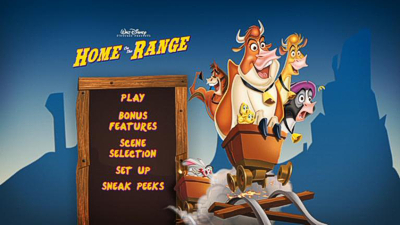
The Main Menu is a pretty static affair, dropping the three randomly selected DVD “intros” that had fun with the DVD experience (voiced by the main cast with cute images of their characters rendered as they might be in a children’s storybook), for a non-special but adequate poster/cover art image and score music approach. Skip the Bonus Features options and you’ll find perhaps the best and meatiest of this disc’s features, a full-length Audio Commentary with the Writers/Directors, Will Finn and John Sanford, as well as producer Alice Dewey. Just as on the Home On The Range DVD, Disney seems shy about advertising their commentary track for this title (once again, it isn’t even mentioned anywhere on the packaging either), but nevertheless this is where Disney fans should go first!

It was a track that I remember liking first time around, and what’s still refreshing another go around is that Finn, Sanford and Dewey really open up about their production, explaining where the many story changes took place and where characters were switched in various scenes. The amiable trio carry the conversation well throughout the film’s length, pointing out their own vocal and character “cameos”, as well as how they wanted to get away from the “pretentious” then-recent animated features and just “do something fun”, plus the use of belching in animated films! Strange as to why the track is again not mentioned anywhere notable, rest assured that it has been carried over here: you’ll find it in the Set-Up language options, making for not only an essential inclusion but a welcome one that definitely marks the disc up in terms of catalog attention the title has received.
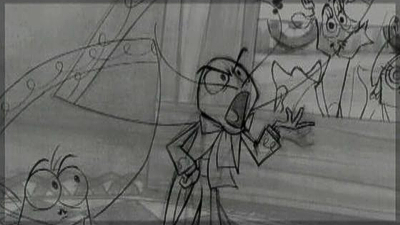
Heading into the Bonus Features proper, we find a bunch of Deleted Scenes cut from the picture. Played with opening remarks from the directors, there are four scenes here that add up to around 15 minutes of screen time (in letterboxed 4:3 widescreen: all the supplements here remain in standard, but very good, definition). The usual blend of storyboard and rough animation, these were clearly abandoned concepts that were left by the wayside as the film twist and turned through developmental changes. A couple of them look fun enough to have been worked into the film again, especially the butterfly narrators (which open the film in a wildly different style ten times better than the bland and obvious take we end up with) that features an alternate and completed deleted song in full. A thrilling coyote chase and an extended scene with Lucky Jack meeting the cows would have bolstered the overall running time of the feature, but they were all cut with reasonable grounds and at least we get to see them here.
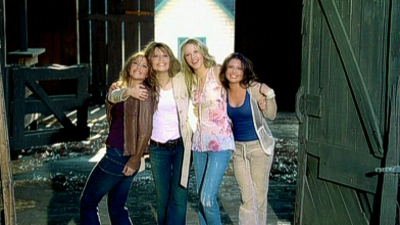
Fluffy but nice to have been ported across as the only kind of promotional material for the movie itself on this disc is the music video for Anytime You Need A Friend, performed as on the closing credits by the Beu Sisters. A fairly standard promo, this has the aforementioned (and very photogenic!) girls singing the song in a farm setting (presumably to hint at the western theme) interspersed with shots from the animated moooovie (oh, come on, I had to put that somewhere)! A good enough track, and a fine example of a film/pop crossover song, it’s well produced and runs just over a full three minutes…much more appetising than Disney’s usual cut-down music clips that simply advertise a movie’s CD soundtrack, and it looks good too: the healthy AVC bitrate making sure the SD video is as fresh looking as can be across the disc.
Going behind the scenes, the almost 17-minute Trailblazers: The Making Of Home On The Range featurette covers the basics and more in its packed running time. The history of the film as Sweating Bullets is touched on, as well as story inspirations and the history of the animated West in Disney cartoons. As well as writer/directors Finn and Sanford, we hear from composer Alan Menken and lyricist Glenn Slater, a nice nod to the musical score, which so often gets overlooked in these kinds of behind-the-scenes efforts. This is a great little piece (with a fun silent movie opening), never becoming too full of fluff and always concentrated on the task at hand: profiling the production of the film. Around ten members of the principal crew get a moment to say what they have to say, and though one may wish that it were a teensy bit longer, there’s not really much that could really be added to here.

Complementing the developmental aspect of the commentary and the featurette is a ten-minute Art Review featurette, narrated by art director David Cutler and head of backgrounds Cristy Maltese. A collection of photos from a trip to Wyoming, concept art, production stills and character designs, this neatly wraps up the visual development for Home On The Range into one slickly presented package, with the bonus of having the artists on hand to deliver more info on a specific image than a standard stills gallery could. A bonus is the fact that, although again only presented in standard definition, the viewer can pause the clip at anytime to take in any of the artwork that may fly by a little too quickly, and you should find that upscaling the very clean image should offer as good a look as any at the production’s artwork.
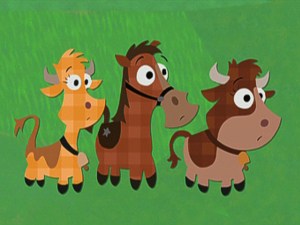
Next up, and possibly the most disappointing crossover, is A Dairy Tale: The Three Little Pigs, which looks almost awful and not anywhere as clean and clear as the other extras, for some reason. Although this Three Little Pigs isn’t one of the Jay Ward-like Totally Twisted Fairytales that Disney sponsored in the mid-1990s, it is a very funny short directed by Finn and Sanford featuring the bovine stars (and original voices) of Home On The Range. The cartoon takes its “storybook” visual style from the film’s closing credits, with cuter, rounder renderings of the main characters bumbling their way through Mrs Caloway’s reading of The Three Pigs. At just around three minutes, it’s a short and sweet affair, but snappily paced, and one that was again both surprising and most welcome on the original DVD, even if it unfortunately doesn’t look any better here.
The original DVD contained a “Yodel Mania!” section that featured a bit of interactive family fun including a game and yodel maker ROM addition. Those have been understandably dropped – and aren’t really missed – but the same section’s Yodelmentary featurette is still here, adding up just over two-and-a-half minutes of mixed-media footage that provides a snappy history of yodelling and how to do it, in keeping with a theme from the main feature. Finally from that disc, The Joke Corral: Herd Of Jokes has the film’s characters telling jokes…it’s that simple, but thoroughly enjoyable if you’re someone like me who groans with laughter whenever a lame pun is bandied about! The jokes (around 18 of ’em, complete with purposely tacky studio laughter), are here grouped as a running selection, running four-and-a-half minutes, with limited animation that fits in well the Three Pigs short, but looking much, much better.
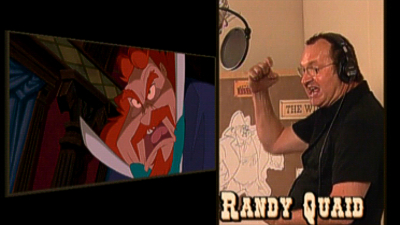
I have to say that, given the poor reception at the box office, it’s nice to see that, as with the concurrently-issued Treasure Planet Blu-ray, Disney has not decided to simply abandon the original bonus features and issue a bare bones disc. In revisiting the title, a trailer or two would have been welcome new extras, but Home On The Range was previewed relentlessly in its theatrical run up and I’d be surprised if you didn’t already have one tucked away on a previous Disney disc or two in your collections. But even without any additions the supplements here still manage to cover the basics in terms of what an expanded set would have done, with extras that are enlightening, surprisingly in-depth and filled with a lot of entertainment value.
Case Study:
In keeping with Disney’s traditionally blu-rimmed cover art, Home On The Range comes to hi-def disc without any kind of “anniversary” or “special edition” tags (even with the disc could be described as such) so the top of the sleeve looks a little barren compared to the Diamond Editions or even most of the Mouse House’s usual catalog upgrades. A four-page DVD Guide from the DVD hasn’t been carried over but at least the title warrants a glossy embossed slipcover in initial pressings – something the DVD didn’t get and nice for fans lining up their Disney classics on their shelves.
It’s a nice touch, again raising the overall mark of the disc up a notch, while a smaller insert offers the usual Movie Rewards code. There’s no Digital Copy, but the enclosed DVD includes all of the supplements described above (with the Commentary correctly grouped with the other extras), meaning this is a freshly authored disc when perhaps copies of the older edition could have been included instead so as to feature the additional set-top game and ROM extras. A front sticker promotes the “music from the composer of Aladdin”, which can only suggest that Disney is prepping that title for a BD debut sometime soon…
Ink And Paint:
Home On The Range’s original 1.66:1 aspect has actually been blown up to fill the 1.78:1 dimensions here, with a sliver of image info missing top and bottom compared to the previous DVD, although this would largely have been lost to overscan anyway. Still, and even though the movie sports a less than elaborate design than many of the more recent Disney features in keeping with its broader cartoon comedy aspirations, it was still created digitally and absolutely pops off the screen in HD.
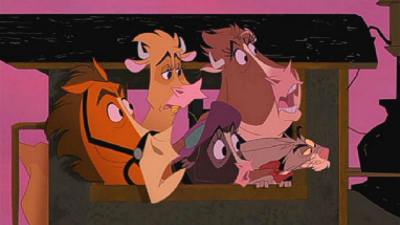
The trade-off is a personal complaint of mine in that some of these direct-to-digital transfers can look at bit too “clinical” sometimes, and this title in particular is so spotless that I actually missed the kind of rough edges that a film-based transfer would have provided, given the subject material. Also, given the bright color palette, the film does sometimes resemble the blander, DTV output from the Studio, but nevertheless it’s a personal gripe and one that won’t upset too many purists – this is to all intents and purposes a truly terrific image!
Scratch Tracks:
When I saw Home On The Range in the theater, I was struck at how mishandled the sound mix was and was very interested to hear how it sounded now in the lossless DTS-HD format that Blu-ray Disc caters for. Hoping for a better representation, for the most part the soundtrack is up to par, with comical effects and the music/songs placed just right in the mix and sounding good and wide. However, and especially in the last reel, which is where things were most disappointed in the theater, everything seems to come crashing down, with dialogue fighting effects and everything else fighting Menken’s score, which in the last few climatic chase moments, seems too buried for long periods of time.
Certainly, I was surprised to see the otherwise fine audio engineers Terry Porter and Mel Metcalfe on the job, since their work has always pleased before, and was hoping that the DTS may have “opened up” the sound more than on the Dolby Digital’s DVD. But it is a good track, and perhaps this is just another personal grumble on my part – with all the frantic action going on in the scenes at these points, I doubt anyone else will bother to care: the track certainly does the job. French, Spanish and Portuguese Dolby dub and sub (also in English) options are also included.
Final Cut:
The “latest Disney” has always been a big deal true fans, although by the time of Home On The Range’s theatrical release the company may have diluted its own uniqueness with an influx of similar product. When the plug was pulled on traditional animation, it was with something of a disappointment that it was on this movie’s watch (strange to think that the Disney legacy could have ended with a movie that resembles a Looney Tune more than anything), even if we can be thankful that the pencils have been picked up again and a tradition continues with The Princess And The Frog and through the Studio’s 50th animated film Tangled, albeit in CG. There are more hand-drawn films to come if the rumor mill is to be believed, all of which is most definitely a good thing.
As such, the onus on Home On The Range as the “last” of the original animated pictures isn’t now so heavy, and while it may not quite be the rootin’est, tootin’est sure firing hit that it could have been, it now sits firmly in a long list of movies which itself contains the odd miss among the hits. But don’t be led to thinking that this is a total misfire – Home On The Range is still enough of a sharp shooter that it sets out and succeeds in bringing a smile to the face and a laugh to the lips. Coupled with a decent disc treatment that’s been carried over to this BD, it provides the kind of strident family film that might be made nowadays – but rendered in classical Disney animation. You go, cow-girls! Yee-haw!
 | ||
 |


